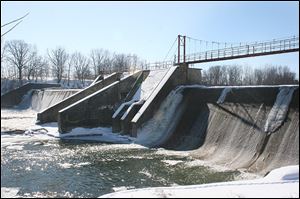
OUTDOORS
Ballville Dam’s fate to be focus of informational session at Terra
2/16/2014

FREMONT — Nobody threw a birthday party when the Ballville Dam turned 100 years old recently. The aging structure, which has spent an extended period of time in hydro limbo while studies and squabbles over its future have regularly stirred up the water, just sits and waits.
The Ballville Dam holds back the Sandusky River about 10 miles upstream from where the waterway dumps into Sandusky Bay. It was originally built to provide hydroelectric power, but those days are ancient history now. However, the dam still separates the river’s short lower section from most of the Sandusky’s 130 mile course.
The river traces its way through rich farmland in Crawford, Wyandot, Seneca, and Sandusky counties, while also draining portions of Huron, Richland, Marion, Wood, Hancock, and Hardin counties. There are close to 2,000 square miles in the watershed served by the river the Shawnee called Potakihiipi, sending some 275 billion gallons of water down the Sandusky and over the Ballville Dam on its way to Lake Erie.
The fate of the dam, which is located in Ballville Township and has not been repaired since 1969, will be the focus of an informational public forum on Wednesday at Terra State Community College, from 7-9 p.m. The session, hosted by the U.S. Fish & Wildlife Service, will be used to present that agency’s Draft Environmental Impact Statement (DEIS) on the disposition of the dam, to the community.
The USFWS report addresses removal of the dam, and also looks at alternatives to removal, and the associated impact of such alternatives. The service said in a news release that it expects the session to “provide an opportunity for dialogue between stakeholders regarding the project.”
The DEIS contains four primary options for the dam — removal with the installation of an ice control structure; an incremental removal over a period of several years; repair with the addition of a fish ladder; or no action. The full report is available for review on the internet at the fws.gov/midwest/fisheries/ballville-dam.html web address, while a hard copy can be viewed at the Birchard Public Library at 423 Croghan St. in Fremont, and at the U.S. Fish and Wildlife Service’s Ohio Ecological Services Field Office at 4625 Morse Road in Columbus.

The Ballville Dam was originally built to provide hydroelectric power. A public forum on Wednesday will discuss the future of the 100-year-old dam.
In a news release accompanying the study, the USFWS summarized that the removal of the Ballville Dam would serve a variety of purposes: restore the natural hydrological processes over a 40 mile stretch of the Sandusky River, re-open fish passage to 22 miles of new habitat, restore flow conditions to allow fish access to new habitat above the dam, and improve overall conditions for native fish communities throughout the river system.
The dam, which is about 400 feet long and 34 feet high, creates a reservoir on the river about two miles long and close to 90 acres in size, and that was the primary water source for the city of Fremont before a costly new upground reservoir was constructed. The Ohio Environmental Protection Agency had pushed for a new water source, citing water quality concerns with the river supply, and indicating that high nitrate levels were present in the river at certain times of the year.
As the future of the dam has been discussed, there has been a push from certain conservationists and government agencies to remove the structure and allow the river to return to its natural flow. This would permit fish to pass back and forth into the upper reaches of the waterway, very likely increasing the quality of the fishery as some 20 miles of the river would be opened up to migratory fish species, including key sport fish such as walleye and white bass.
“Old dams are a problem everywhere, and this thing is 100 years old,” said Bernie Whitt, owner of Anglers Supply just a few blocks from the river in downtown Fremont. “Take the sportfishing part out of it, and you still have to wonder why people wouldn’t want to take the dam down, and then have a river that’s a lot better for their grandkids to enjoy.”
In a study conducted by the Ohio Division of Wildlife more than a decade ago, mature male and female walleye were captured and moved above the dam, where they were able to migrate upstream and find suitable spawning habitat and produce larval walleye.
Biologists also have stated that removing the dam will improve the current walleye spawning habitat in downtown Fremont. Those sections of the river currently used by spawning walleye have been degraded by years of scouring, biologists say, which takes place during periods of high river flow and removes much of the gravel and rubble the fish need for spawning. New material has been unable to reach these spawning grounds due to the dam, but minus the dam these areas could be “recharged” as gravel and rubble would once again wash down the river system.
"Any time you can remove a dam, you've improved a river,” Roger Knight, the now retired head of Lake Erie fisheries management for the Division of Wildlife said in 2011, adding that removing the dam would make significantly more spawning habitat available to walleye that have historically moved in from Lake Erie and used the Sandusky River each spring.
Those opposing the removal of the dam have cited concerns over potential issues with ice and flooding , possible damage to existing estuaries and wetlands, the impact of the release of the huge silt and sediment plug that has accumulated behind the dam over the past century, as well as the uncertainty over the cost of such a project, and other environmental and socioeconomic factors. Some have favored repairing the structure, and installing a mechanism that could potentially allow fish to move upstream past the dam.
Fremont mayor Jim Ellis said this past week that he wants to see all of the alternatives for the dam studied and developed, and then presented to city council. Ellis said that operating in the current regulatory environment, which has the Ohio EPA, ODNR, the U.S. Army Corps of Engineers and the USFWS all involved in some manner, makes this an even more complicated and challenging project.
“We have to look closely at a variety of issues,” said Ellis, who added that a “top-notch” engineering firm is examining the various options with the dam.
Ellis encouraged the public to attend the informational session on Wednesday evening at Terra, where he said tables would be set up to address the major issues and options for the dam. “I want to see people there, and I think we’re going to get a lot of comments on the draft.” He said he expects the city to make a decision on the dam sometime this year.
The public comment period on the USFWS report will end on March 26. Comments can be submitted in writing to Brian Elkington, U.S. Fish and Wildlife Service, Fisheries, 5600 American Boulevard West, Suite 990, Bloomington, MN 55437. They can also be emailed to Elkington at the Ballvilledam@fws.gov address or faxed to 612-713-5289.
Contact Blade outdoors editor Matt Markey at: mmarkey@theblade.com or 419-724-6068.